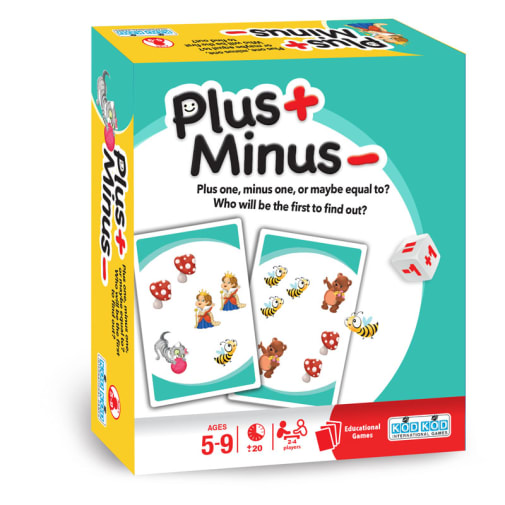Your children will enjoy this suspenseful math card game that uses speed and accuracy to add and subtract on the spot! Each card is featured with several different objects or characters, and the dice has plus, minus, and equal signs. Each player gets a hand of 5 cards, and the rest of the deck goes in a pile face down. The players keep their hand face up on the table in front of them. Flip the top card over and roll the dice. The dice will determine the specific value of the card. The first player to find a card with the right value wins that round, and their card becomes the new card for the next round. The first player to get rid of their deck wins the game. Gameplay can be modified for advanced players. Includes 1 storage box, 45 cards, 1 instruction manual, 1 dice, and 6 stickers (to be placed on dice). Playing time: 20+ minutes, 2 – 4 players.
Plus-Minus Game
SKU
046182
Grade PK-3
These icons are designed to help you quickly understand and learn important information about our products.
Teaching Method
Traditional
Teacher-centered curriculum commonly used in classrooms that may include a text, teacher manual, tests, etc.
Charlotte Mason
A methodology based on the work of a 19th century educator who maintained that children learn best from literature (Living Books), not textbooks.
Classical
A methodology based on the Latin Trivium (three stages of learning), including the grammar stage (memorization and facts), logic stage (critical thinking), and rhetoric stage (developing/defending ideas).
Unit Study
A thematic or topical approach centered around one topic that integrates multiple subject areas.
Montessori (Discovery)
A methodology based on the work of a 20th century educator that emphasizes student and sensory-driven discovery learning and real-life applications.
Other
Other methodologies
Religious Content
Secular
Contains content contrary to common Christian beliefs (i.e. evolution).
Neutral
Avoids religious or theoretical topics or presents multiple viewpoints without preference.
Christian/Religious
Faith-based or including instructional religious content.
Learning Modality
Auditory
Learns through listening, talking out loud or reading out loud.
Visual
Learns through seeing, prefers written instructions and visual materials.
Kinesthetic/Tactile (Hands-On)
Learns through moving, doing and touching.
Multi-Sensory
Curriculum that employ a variety of activities/components.
Presentation
Sequential
Curriculum progresses through well-defined learning objectives. Emphasizes mastery before moving to the next topic.
Spiral
Topics and concepts are repeated from level to level, adding more depth at each pass and connecting with review.
Conceptual/Topical
Focus is on the “why,” often with a unifying concept as well as specific skills; coverage may be broader.
Teacher Involvement
Low Teacher Involvement
Student-led materials; parent acts as a facilitator.
Medium Teacher Involvement
A mix of teacher-led time and independent student work.
High Teacher Involvement
Teacher-led lessons; may utilize discussions, hands-on activities and working together.
Additional Materials Required
No other materials needed
Everything you need is included.
Other Materials Required
There are additional required resources that are a separate purchase.
Other Materials Optional
There are additional resources mentioned or recommended but are not absolutely necessary.
Consumable
Consumable
Designed to be written in; not reusable.
Non-Consumable
Not designed to be written in; reusable.
Our Price
$14.99 $14.99 $12.50
Rainbow Savings: $2.49
Warning
Choking Hazard
- Small parts. Not for children under 3 years.
Description
Publisher's Description of Plus-Minus Game
Plus-Minus helps young children practice basic counting and quantity comparison skills, and older children can improve their existing skills as well! Every player starts with five cards depicting various images that they'll try to match to a faceup card in the middle of the table. However, before they do that, they'll role the die to see if they'll need to find a match that either adds, subtracts, or equals the symbols on the shared card.
Details
| Product Format: | Other |
|---|---|
| Grades: | PK-3 |
| Brand: | Kod Kod |
| EAN/UPC: | 7290108380804 |
| Length in Inches: | 5.75 |
| Width in Inches: | 4.75 |
| Height in Inches: | 1.875 |
| Weight in Pounds: | 0.4 |
Videos
Reviews

